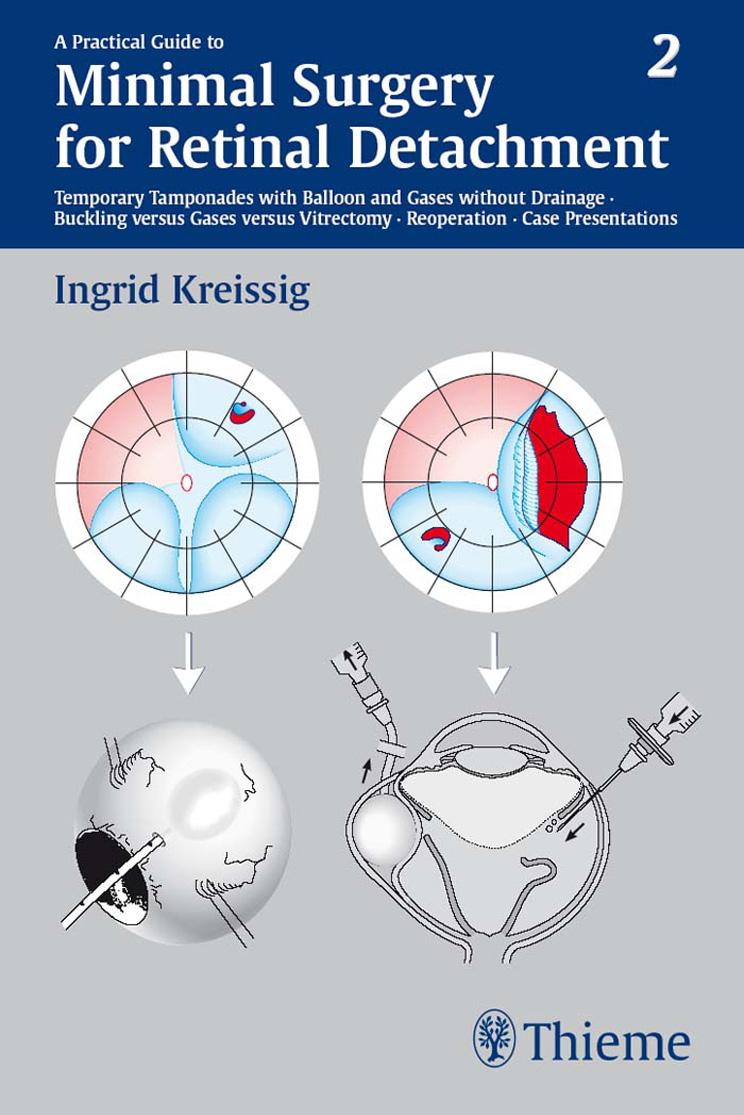A Practical Guide to Minimal Surgery for Retinal Detachment Volume 2 1st edition by Ingrid Kreissig ISBN 313257872X 9783132578722
$70.00 Original price was: $70.00.$35.00Current price is: $35.00.
Instant download Practical Guide to Minimal Surgery for Retinal Detachment Volume 2 Temporary Tamponades with Balloon and Gases without Drainage Buckling versus Gases versus Vitrectomy Reoperation Case Presentations A after payment
A Practical Guide to Minimal Surgery for Retinal Detachment Volume 2 1st edition by Ingrid Kreissig – Ebook PDF Instant Download/Delivery: 313257872X, 9783132578722
Full download A Practical Guide to Minimal Surgery for Retinal Detachment Volume 2 1st edition after payment

Product details:
ISBN 10: 313257872X
ISBN 13: 9783132578722
Author: Ingrid Kreissig
Dr. Kreissig has spent a lifetime refining and teaching the minimalized approach to repairing retinal detachments. Get the benefit of her experience in an easily accessible, pocket-sized handbook that fits into your lab coat and is also ideal for bedside or office consultation. Volume 2 describes the “art of a minimal approach” by using the balloon or the gases or as reoperation, as treatment for various retinal detachments. The text is excellently illustrated, written in an easy-to-understand fashion and in a dialogue style. Important facts are highlighted in red boxes. The four rules to find the break in a reoperation are depicted on the back cover, thus easy to be looked up. The reader is taken step-by-step through each procedure for easy and more complex detachments. In separate chapters, extraocular and intraocular techniques for retinal reattachment are compared to reoperation.
Ophthalmologists, fellows in retinal and vitreous surgery, students and residents will find this information-packed manual essential for diagnosing and repairing retinal detachments. Reserve your copy today!
A Practical Guide to Minimal Surgery for Retinal Detachment Volume 2 1st Table of contents:
9 Temporary Balloon Buckle without Drainage: Minimal Extraocular Surgery for Retinal Detachments with 1 Break or Breaks within 1 Clock Hour
9.1 Introduction
9.2 History
9.3 Principle of the Balloon Procedure
9.4 Instrumentation and Surgical Technique
9.5 Practical Tips when Starting with the Balloon Procedure
9.6 Indications
9.6.1 Small Detachment
9.6.2 2-Quadrant Detachment
9.6.3 3-Quadrant Detachment
9.6.4 Total Detachment in a Pseudophakic Eye
9.6.5 Detachment with a Break beneath a Muscle
9.6.6 Old Detachment
9.6.7 As Diagnostic Probe to Detect the Break or to Exclude the Presence of Another Break: Examples 1 to 6
9.6.8 To Rescue a Failing Buckle
9.6.9 As Late Reoperation
9.6.10 Staphylomatous Sclera
9.6.11 Detachment in a Glaucomatous Eye
9.6.12 Balloon-Aided Vessel-Occlusion Technique
9.6.13 Basic Balloon–Gas Procedure: Creating Space for an Intraocular Gas Injection
9.7 Results
9.7.1 Anatomical Results
9.7.1.1 First Clinical Study
9.7.1.2 Second Clinical Study
9.7.2 Functional Results
9.7.3 Complications
9.7.4 Conclusion
References
10 Temporary Gas Tamponades without Drainage: Minimal Intraocular Surgery for Retinal Detachments
10.1 History
10.2 Sulfur Hexafluoride (SF6)
10.2.1 History
10.2.2 Clinical Study with Expanding-Gas Operation without Drainage
10.2.3 Conclusion
10.3 The Perfluorocarbon Gases
10.3.1 The Cyclo-Perfluorocarbon Gas
10.3.2 The Straight-Chain Perfluorocarbon Gases
10.3.2.1 Physical Properties
10.3.2.2 Complications
10.3.2.3 Conclusion
10.4 Instrumentation and Surgical Technique
10.4.1 Preoperative Phase
10.4.2 Intraoperative Phase
10.4.3 Postoperative Phase
10.5 Balloon–Gas Procedures: Basic Procedure and Extended Procedure
10.5.1 History
10.5.2 Principle of the Balloon–Gas Procedures
10.5.3 Instrumentation
10.5.4 Surgical Technique
10.6 Application of Expanding Gases
10.6.1 Large Tears and Giant Tears
10.6.1.1 Large Tears
10.6.1.2 Giant Tears and Various Gas Techniques
10.6.1.2.1 Lateral Giant Tear
10.6.1.2.2 Lateral Giant Tear with Additional Horseshoe Tears
10.6.1.2.3 Rolling Gas Bubble Technique
10.6.1.2.4 Superior Giant Tear with a Flap Overhanging the Disk
10.6.1.2.5 Small Gas Bubble Technique
10.6.1.2.6 Backward Rotation around a Small Gas Bubble
10.6.1.2.7 Superior Giant Tear with a Flap Overhanging the Disk and Additional Horseshoe Tears
10.6.1.2.8 Superior Lateral Giant Tear with Detached Horseshoe Tears and Moderate Vitreous Hemorrhage
10.6.1.2.9 Superior Giant Tear Posterior to Equator with Rolled-Over Posterior Flap and Detached Horseshoe Tears
10.6.1.2.10 Giant Tear of 350° with an Inferior Rolled-Over Posterior Flap
10.6.1.2.11 Forward Rotation around a Small Gas Bubble
10.6.2 Group of Breaks at Different Latitude
10.6.2.1 Group of Breaks and Posterior Hole
10.6.2.2 Group of Anterior and Posterior Holes Extending over 1 Quadrant
10.6.2.3 Conclusion
10.6.3 Posterior Holes
10.6.3.1 Fundamentals for the Gas Technique
10.6.3.2 Examples
10.6.3.3 Conclusion
10.6.4 Diagnostic Gas Bubble and Gas-Exchange Techniques
10.6.4.1 Rationale of Diagnostic Gas Bubble Technique
10.6.4.2 Clinical Application
10.6.4.3 Gas-Exchange Techniques
10.6.4.4 Conclusion
10.6.5 Clinical Study
10.6.5.1 Patients and Expanding-Gas Operation
10.6.5.2 Results
10.6.5.3 Complications
10.6.5.4 Conclusion
10.6.5.5 Reasons for Failure in Giant Tears
10.6.5.6 Conclusion
10.7 Pneumatic Retinopexy
10.8 Retrohyaloidal Gas Injection
10.8.1 Introduction
10.8.2 Technique
10.8.3 Patients and Results
10.8.4 Conclusion
10.9 Xenon Gas
10.9.1 Introduction
10.9.2 Clinical Study
10.9.3 Applications
10.9.4 Conclusion
References
11 Balloon Buckle versus Pneumatic Retinopexy for Uncomplicated Retinal Detachments
11.1 Introduction
11.2 Differences between Balloon Operation and Pneumatic Retinopexy
11.2.1 Application
11.2.2 Surgical Technique
11.2.3 Postoperative Management
11.3 Clinical Studies
11.3.1 Results
11.3.2 Complications
11.4 Conclusion
11.5 Summary
References
12 Limits of External Buckling in Treating Complicated Retinal Detachments
12.1 Background
12.2 Limits of External Buckling
12.2.1 Due to Location or Size of Tear
12.2.2 Due to Vitreous Traction
12.2.3 Due to Opacities within the Optic Media
12.3 Conclusion
References
13 Pneumatic Retinopexy versus Vitrectomy as Primary Procedure for Retinal Detachments
13.1 Background
13.2 Results
13.3 Conclusion
References
14 Reoperation of Retinal Detachments without Drainage: Minimal Extraocular Surgery as Rational Approach
14.1 Introduction
14.2 History
14.3 Patients and Methods
14.4 Results
14.4.1 First Category of Surgical Failure: An Undetected Break. The 4 Rules to Find the Undetected Break in Reoperation
14.4.2 Second Category of Surgical Failure: An Inadequate Buckle. The 3 Reasons for an Inadequate Buckle
14.4.3 Third Category of Surgical Failure: “It Must Be Traction”
14.5 Conclusion
14.6 Checklist for Reoperation as Minimal Approach
References
Index
People also search for A Practical Guide to Minimal Surgery for Retinal Detachment Volume 2 1st:
minimal procedure
a practical guide to dermoscopy
a practical guide to operative surgery
bariatric surgery best practice guidelines
clinical practice guidelines for surgery
Tags: Ingrid Kreissig, A Practical, Retinal Detachment, Minimal Surgery


